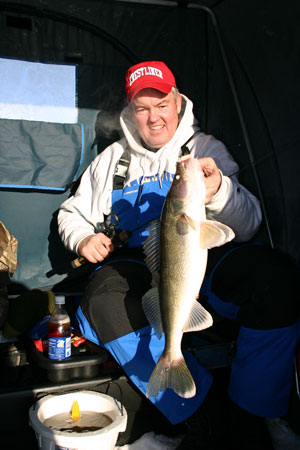Going for the Gold-Late
Season Walleyes
by Ron Anlauf
Late season walleye fishing through the ice has itís rewards, though
 few
step up and claim the prize. By late January, most anglers have given up
and thrown in the towel. A couple weeks of tough fishing can do that to
you. Itís easy to write the rest of the season off, besides it wonít be
that long before you get a chance at some open water. The real diehards
however, never say die. They know that for those that stick it out there
is some serious action yet to be had.
few
step up and claim the prize. By late January, most anglers have given up
and thrown in the towel. A couple weeks of tough fishing can do that to
you. Itís easy to write the rest of the season off, besides it wonít be
that long before you get a chance at some open water. The real diehards
however, never say die. They know that for those that stick it out there
is some serious action yet to be had.
One of the keys to late season action is retracing your steps, and
looking in the places that held good numbers of fish earlier in the
season. Those are shoreline related hard bottom areas like rock covered
bars and humps, and the spots that anglers made a beeline for as soon as
the ice was safe enough to allow it.
Early season action is more like a race, than anything else. It takes
on the similarities of a race when anglers try to get ahead of their
fellow anglers and beat them to the next hot spot. Staying ahead of the
crowd is one of the keys to really hot ice fishing action. The first
anglers to arrive at a spot are able to get their lures in front of fish
that havenít been bothered yet. They also have the undivided attention
of all of the biters, and donít have to share them with anyone else.
When the rest of the crowd shows up things change, and not for the
better. How many times have you heard about the action getting better
after a mob of anglers arrived on the scene? Probably never. More
anglers mean more lines and more baits for the biters to choose from.
There are only so many of the willing to go around, no matter how good
the spot may be. Another thing hordes of anglers bring with them is
noise, and lots of it.
Holes being drilled and cars being driven can create a tremendous
amount of noise. When a car or truck passes in the distance, you can
hear the ice cracking long before you hear the vehicle noise. Whether or
not fish can hear it or feel it, they definitely react to it. They react
to it by shutting down, changing periods of activity, or getting out of
Dodge.
When you combine all of these factors with the general seasonal slow
down, you end up facing some pretty tough fishing conditions. Those are
the very same conditions that send anglers packing, never to return
until the next hard water period.
Sometime between now and the seasonís end, walleyes begin to show up
on those aforementioned areas and are definitely catchable. The same
techniques that produced so well earlier in the season can still get the
job done. That means using jigging spoons, set lines with floats, and
tip ups.
Jigging spoons are a go to bait and always have the potential for
putting walleye gold on ice. Lighter spoons like Northland Tackleís
Fire-Eye Minnow have a slow fluttering drop and tipped with a minnow (or
piece of one) can be extremely deadly, in the right hands. When the
walleyes are really going theyíll fall for just about any jigging
technique you show them, but when they slow down you may need to change
up a bit to keep getting your pole bent. Instead of a hard snap on the
lift you might try tiny lifts of the rod tip, followed by long periods
of remaining perfectly still, especially if you have a fish staring down
your bait. If your bait is getting a serious look without any
commitment, try quivering the rod tip from side to side, instead of up
and down. Youíd be surprised by how much action youíre really imparting
to your bait with such a small amount of movement.
One of the keys to successful spooning is sticking with it, and not
giving up. Jigging a spoon all day without any takers can be incredibly
monotonous. Lack of success may be as simple as where youíre doing it,
rather than how.
Even if they donít get the appropriate response spoons can be
expected to at least draw fish in close enough for them to be seen on a
depth finder. With an electronic depth finder like the Marcum LX-3 you
can watch how walleyes react to your bait and adjust accordingly. If
what youíre doing is working keep itup, if not you may have to make some
tiny adjustments to get a positive response.
If youíre not seeing fish on the depth finder you may have to make a
move in order to find a few takers and will depend on the area youíre
fishing. Shallower areas on deeper structure may not see much activity
until sundown and you may have to stick it out to know for sure. Deeper
edges and breaks are more apt to hold active fish during the day and are
the high percentage spots.
Being mobile is the key and where gas powered augers and portable
shelters like the revamped Fishtrap Voyager are in order. The Voyager
has a retooled heavy duty sled that is built for long hauls behind ATVs
or snowmobiles. It also has new adjustable padded swivel seats that are
super comfortable and will helpkeep you on the ice much longer, which is
where you belong.
Options like suspending a minnow below a bobber, or tip-up, may also
be in order. Spoons can attract and nail the aggressive fish while
bobbers and tip-ups may coax some of the slackers. Slackers are not
inclined to move very far (or work very hard) to take a bait. The key is
keeping a bait in front of them long enough to get a response.
To help even further with the slacker factor, try replacing a plain
hook with a smaller jig head. Active minnows can swim up and out of the
tiny strike zone that may exist, while the weight of a jig head will pin
the bait in place. See you on the ice, one last time.




 few
step up and claim the prize. By late January, most anglers have given up
and thrown in the towel. A couple weeks of tough fishing can do that to
you. Itís easy to write the rest of the season off, besides it wonít be
that long before you get a chance at some open water. The real diehards
however, never say die. They know that for those that stick it out there
is some serious action yet to be had.
few
step up and claim the prize. By late January, most anglers have given up
and thrown in the towel. A couple weeks of tough fishing can do that to
you. Itís easy to write the rest of the season off, besides it wonít be
that long before you get a chance at some open water. The real diehards
however, never say die. They know that for those that stick it out there
is some serious action yet to be had.